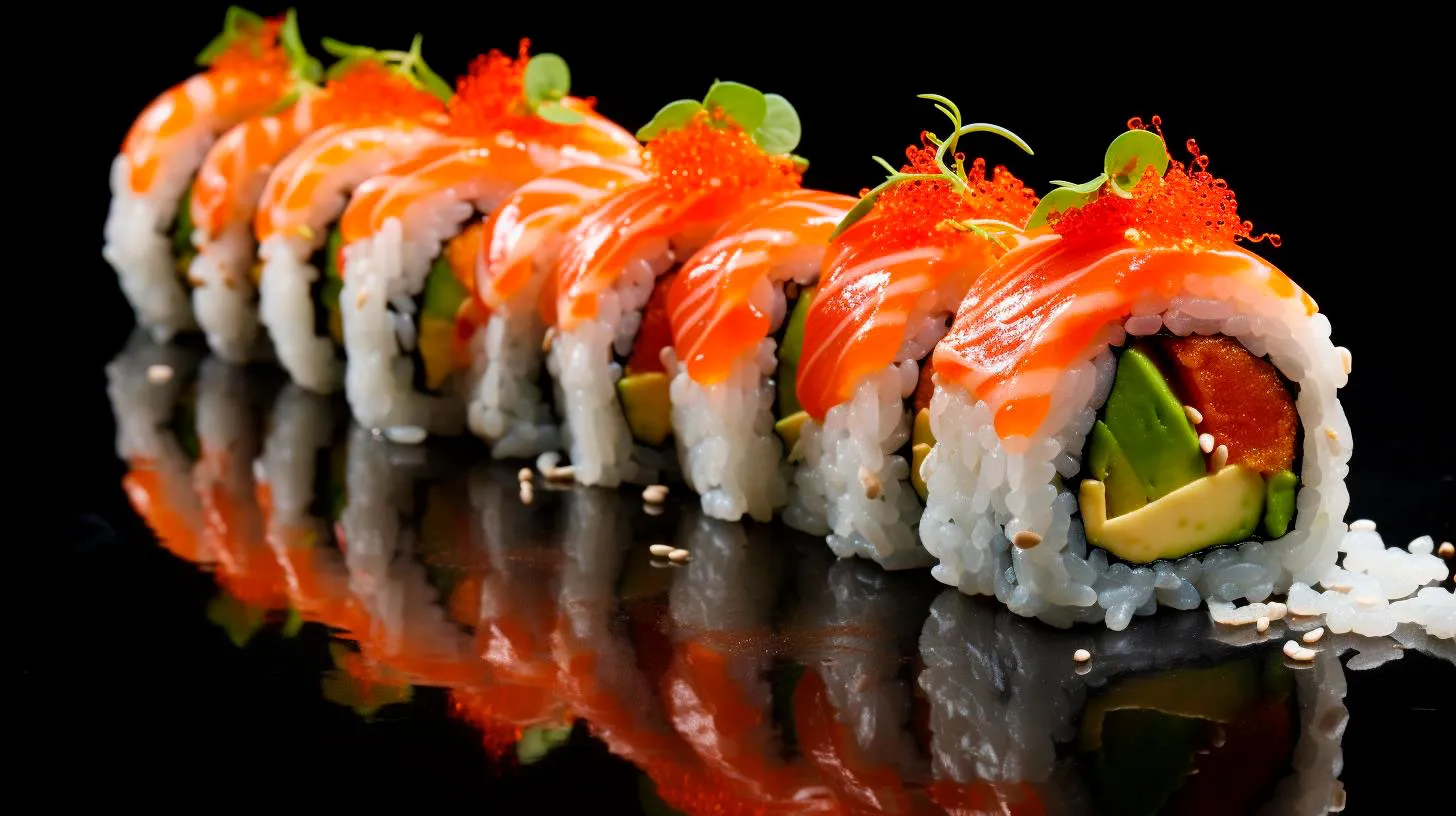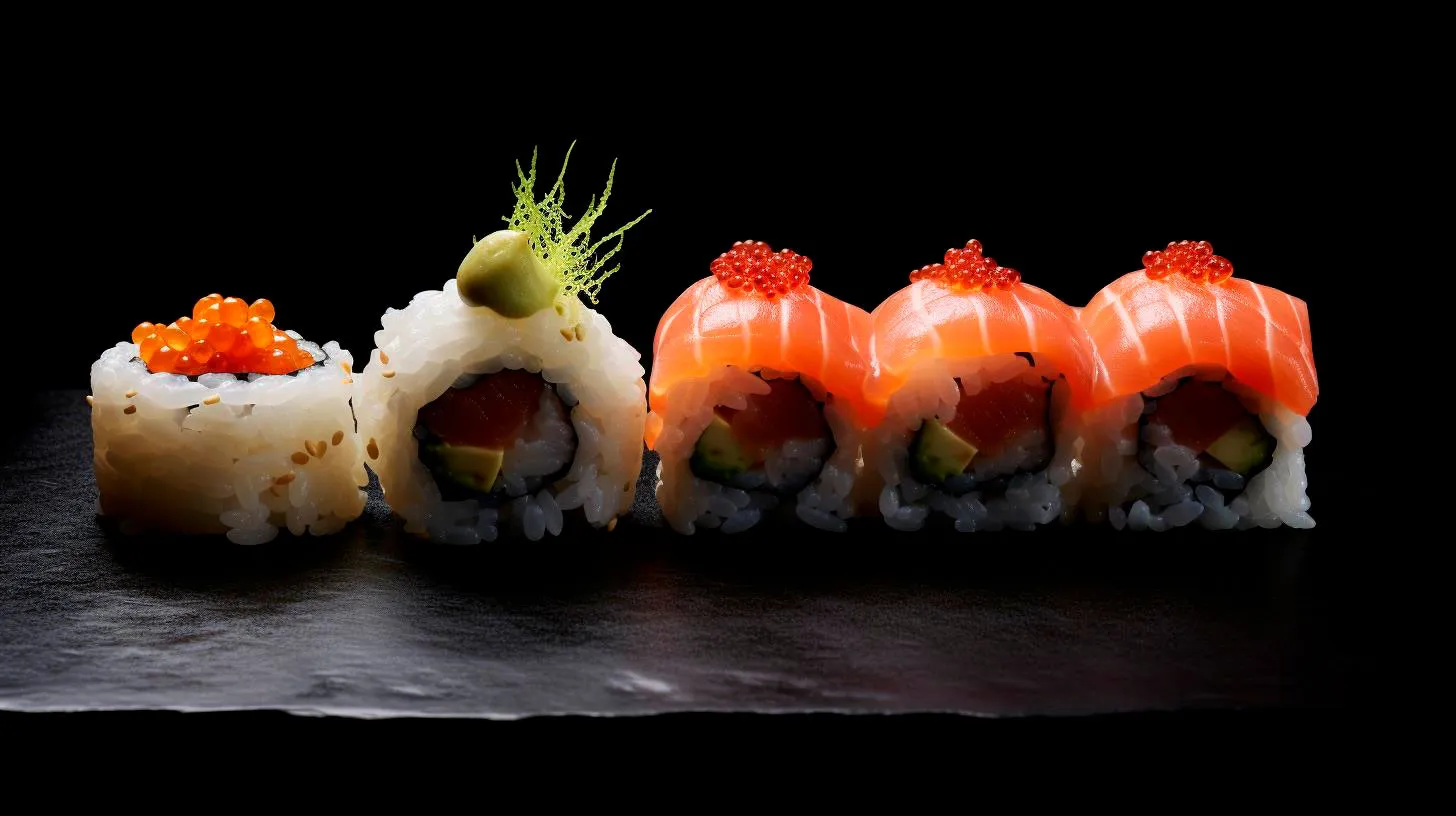From Tradition to Innovation: Pushing the Boundaries of Sushi
Today, we dive into the world of sushi, exploring its evolution towards modernity and the exciting new experiences it brings to the table.
The Traditional Art of Sushi Making
Traditional sushi is an art form that dates back centuries. Crafted by skilled sushi chefs, this delicacy showcases the perfect balance of flavors and textures. The traditional sushi-making process involves meticulous precision and adherence to specific techniques, such as the proper slicing of fish and the precise ratio of rice to fish.
Key Takeaway: Traditional sushi making requires precision and specific techniques to achieve the perfect balance of flavors and textures.
Sushi’s Journey into Modernity
While the art of traditional sushi-making remains highly respected and revered, innovators in the culinary world have embraced sushi’s potential for creativity. With the goal of offering unique experiences to diners, sushi chefs are now pushing the boundaries and exploring new ingredients, techniques, and presentations.
One prominent example is the fusion of different culinary influences with traditional sushi, resulting in tantalizing flavor combinations. Creative sushi rolls, such as the California roll with avocado and crab, have become fan favorites worldwide.
Advantage: Fusion sushi rolls offer unique flavor combinations, appealing to a wider range of tastes.
Another innovation is the introduction of non-traditional ingredients. Sushi chefs are venturing beyond the boundaries of traditional fish options, incorporating unexpected elements like fruits, vegetables, and even tofu. These innovative ingredients provide a refreshing twist to the traditional sushi experience.
Advantage: Non-traditional ingredients expand sushi options for vegetarians and health-conscious individuals without compromising on taste or presentation.
The Rise of Sushi Technology
Technology has also made its mark on this traditional cuisine. Sushi-making robots have become a common sight in various restaurants, allowing for increased efficiency and precision in the sushi-making process. These machines can precisely measure and cut fish, ensuring consistent quality and reducing the risk of human error.
Advantage: Sushi-making robots enhance the consistency and quality of sushi production, providing a reliable dining experience for customers.
The Sushi Revolution: Conveyor Belt Sushi
Conveyor belt sushi, or kaiten sushi, has revolutionized the way people experience sushi. This innovative dining concept involves placing plates of sushi on a moving conveyor belt, allowing diners to select their preferred dishes as they pass by.
Kaiten sushi offers several advantages:
- Convenience: Diners can easily pick their preferred dishes as they circulate on the conveyor belt, saving time and effort.
- Experience: Watching the sushi move along the belt adds an element of entertainment to the dining experience, making it enjoyable for both adults and children.
- Affordability: Kaiten sushi restaurants often offer competitive prices, making it more accessible for sushi enthusiasts on a budget.
Sustainable Sushi: A Growing Trend
With the increasing focus on sustainability, the sushi industry has also undergone significant changes. Sushi restaurants are now more conscious about the environmental impact of their practices and are exploring sustainable alternatives.
One key aspect is responsible sourcing of fish. To ensure sustainable fishing practices, many sushi establishments exclusively partner with suppliers who follow strict guidelines, including only sourcing fish from well-managed fisheries.
Advantage: Responsible sourcing of fish promotes sustainable fishing practices and helps preserve marine ecosystems for future generations.
Additionally, alternatives to traditional ingredients have emerged. Plant-based sushi rolls and creative substitutes for raw fish, such as tofu or mushrooms, have gained popularity among eco-conscious diners.
Key Takeaway: Sustainable sushi practices focus on responsible fish sourcing and offer eco-friendly alternatives to traditional ingredients.
In Conclusion
Sushi, with its rich history and traditional roots, has embraced innovation and pushed the boundaries of what was once considered the norm. From the fusion of flavors and non-traditional ingredients to the use of technology and sustainable practices, sushi is thriving in the modern culinary world.
Whether you prefer the traditional art of sushi making or the exciting flavors of fusion rolls, there is something for everyone. As sushi continues to evolve, it remains an ever-engaging and delectable culinary adventure, perfect for both the traditionalists and the adventurous food enthusiasts.
The Art of Sushi: A Culinary Obsession
In this blog post, we will explore the art of sushi, its history, health benefits, and why it has become a culinary obsession worldwide.
The Origins of Sushi
Sushi, as we know it today, has a rich heritage that dates back to ancient Japan. Its origins can be traced to the Edo period, where it began as a method of preserving fish using fermented rice. Over time, people discovered that allowing the fish to ferment for shorter periods resulted in a more enjoyable flavor. This technique, known as narezushi, eventually evolved into what we now recognize as sushi.
During the 19th century, sushi underwent a transformation with the introduction of vinegared rice, known as sushi-meshi. This innovation made sushi more palatable and helped it gain popularity among the masses. Today, sushi comes in various forms, such as nigiri, maki, sashimi, and temaki, each with its own unique characteristics and flavors.
The Artistry of Sushi
One of the most remarkable aspects of sushi is the precision and artistry involved in its preparation. Skilled sushi chefs train for years to perfect their techniques, striving for culinary excellence with each dish they create. The presentation of sushi is equally as important as its taste, with chefs meticulously arranging each element on the plate to create a visually stunning masterpiece.
The artistry of sushi extends beyond its visual appeal. The selection and combination of ingredients are carefully chosen to complement and balance each other. From the freshness of the fish to the texture of the rice, every aspect is considered to achieve the perfect harmony of flavors in every bite.
The Health Benefits of Sushi
Sushi is not just a feast for the eyes and taste buds; it also offers numerous health benefits. Here are some reasons why sushi has become a go-to choice for health-conscious individuals:
- High in Omega-3 Fatty Acids: Fish, a primary ingredient in sushi, is an excellent source of omega-3 fatty acids. These essential fats are known to promote heart health, reduce inflammation, and support brain function.
- Rich in Vitamins and Minerals: Sushi often incorporates seaweed, which is packed with essential vitamins and minerals, including iodine, calcium, and iron.
- Low in Calories: Compared to many other cuisines, sushi is generally low in calories. It offers a flavorful and satisfying meal without the guilt associated with indulgent dining options.
- Provides Antioxidants: Sushi often includes ingredients like ginger and wasabi, which are rich in antioxidants. These compounds help protect the body against cell damage and boost the immune system.
The Global Obsession with Sushi
Sushi has transcended cultural boundaries, gaining popularity worldwide. Today, you can find sushi restaurants in almost every major city, catering to a growing demand for this culinary delight. Here are a few reasons why sushi has become a global obsession:
- Healthy and Nutritious: As mentioned earlier, sushi offers a healthy and nutritious dining option, appealing to those seeking a balanced diet.
- Adventure for the Palate: Sushi provides a unique culinary experience, allowing individuals to explore a wide variety of flavors and ingredients they may not have encountered before.
- Social and Interactive: Sushi is often enjoyed with friends or family, making it a social and interactive dining experience. Sushi bars with open kitchens allow patrons to witness the skill and precision of sushi chefs firsthand.
- Diversity and Customization: Sushi’s versatility allows for a range of options to suit various dietary preferences. Whether you’re a vegetarian or a seafood lover, there’s a sushi roll to satisfy every palate.
- The Rise of Food Tourism: The increasing popularity of food tourism has contributed to the global obsession with sushi. Travelers seek out authentic culinary experiences, and sushi has become a must-try dish in many destinations.
Key Takeaways
Sushi is more than just a meal; it is a work of art. Its delicate flavors, meticulous preparation, and health benefits make it a standout culinary choice. Whether you’re a sushi aficionado or a curious newcomer, exploring the world of sushi is an adventure worth undertaking.
So next time you find yourself craving a memorable dining experience, indulge in the art of sushi and savor each bite knowing you’re benefiting from its nutritional value as well.
Unraveling the Secrets: Exploring the Intricacies of Sushi-Making
In this article, we will delve into the hidden secrets of sushi-making, uncover its rich history, and reveal the key elements that make this delicacy so beloved.
The Art and Science of Sushi
Making sushi is more than just assembling different ingredients; it is both an art and a science. The process of sushi-making involves several key components:
- Sushi Rice: The foundation of any sushi dish is the rice. Sushi rice, also known as shari, is a short-grain rice seasoned with a mixture of rice vinegar, sugar, and salt. The addition of this combination gives the rice its signature tangy flavor and sticky texture.
- Sashimi: Sashimi refers to the fresh, raw fish or seafood slices served without rice. It is crucial to select high-quality, fresh ingredients to ensure the utmost flavor and texture.
- Norimaki: Norimaki, commonly known as sushi rolls, are made by wrapping sushi rice, fish, and vegetables in a sheet of nori (seaweed) and then slicing it into bite-sized pieces. The combination of flavors and textures makes these rolls a favorite among sushi enthusiasts.
- Nigiri: Nigiri sushi consists of a hand-pressed mound of sushi rice topped with a slice of fish or seafood. The delicate balance between the rice and the topping is essential to create a harmonious bite.
The History of Sushi
Sushi’s origins date back to the 7th century in Southeast Asia, where people preserved fish in fermented rice. This technique helped to preserve the fish and enhance its flavor. Over time, sushi evolved, and during the 17th century, a chef named Hanaya Yohei introduced the concept of serving sushi using only freshly prepared ingredients. This innovation marked the beginning of what is known today as Edo-style sushi.
Fast forward to the 20th century, sushi gained popularity outside of Japan, particularly in the United States. With growing international demand, sushi chefs began experimenting with new ingredients and techniques, giving rise to fusion sushi, such as California rolls and spicy tuna rolls.
The Secrets Behind Great Sushi
Creating a masterpiece sushi dish requires more than just technical skills. Here are some of the secrets that sushi chefs employ to achieve exceptional flavors:
- Freshness: Using the freshest ingredients is crucial when it comes to sushi. Chefs carefully select their fish and seafood to ensure the best quality and taste. Freshness guarantees a delightful burst of flavors.
- Knife Skills: Sushi chefs undergo years of training to master the art of knife skills. The way they slice the fish affects how the flavors meld with the rice and other ingredients, ultimately enhancing the overall experience.
- Temperature Control: Proper temperature control is crucial during the sushi-making process. Cold ingredients like fish and rice are carefully handled to ensure optimum freshness and taste.
- Balance of Flavors: Sushi is all about achieving balance. Chefs pay careful attention to the harmony between the flavors of the rice, the fish or seafood, and any additional ingredients. Each bite should be a culinary symphony.
Key Takeaways
Now that we have unraveled the secrets behind sushi-making, let’s recap the key takeaways:
- Sushi-making is a combination of art and science, requiring precision and attention to detail.
- The main elements of sushi-making are sushi rice, sashimi, norimaki, and nigiri.
- Sushi originated in Southeast Asia and evolved into various styles, with Edo-style sushi being a significant milestone.
- Freshness, knife skills, temperature control, and flavor balance are essential factors for creating outstanding sushi.
Sushi-making truly is an intricate craft that combines culinary expertise, cultural heritage, and a deep appreciation for quality ingredients. Whether you are a sushi enthusiast or a novice, understanding the secrets and intricacies behind this beloved dish allows you to fully appreciate the artistry and skill that goes into each sushi roll you savor.
Mastering the Craft: A Lifetime Devoted to Sushi Mastery
In this article, we delve into the world of sushi mastery, exploring the journey, skills, and dedication required to become a sushi maestro.
The Journey Begins: Apprenticeship and Training
Mastering the art of sushi begins with an apprenticeship under a seasoned sushi chef. Malcom Gladwell’s 10,000-hour rule comes into play here as sushi apprentices typically spend a minimum of ten years honing their skills. During this time, they are immersed in all aspects of sushi-making, from preparing the perfect sushi rice to mastering the technique of slicing raw fish.
Key takeaways:
- An apprenticeship is a crucial starting point for aspiring sushi chefs.
- Apprenticeships can span over a decade
- During this time, apprentices gain hands-on experience in every aspect of sushi preparation.
Dedication to Precise Techniques
Sushi-making is ultimately an art of precision. Chefs must craft sushi pieces with utmost accuracy and finesse. It involves forming nigiri, rolling maki, and shaping other intricate sushi styles. Even the simplest sushi requires perfect execution to achieve an optimal dining experience.
Key takeaways:
- Precision and attention to detail are integral to the sushi-making process.
- Sushi chefs must hone their skills in forming nigiri, rolling maki, and other techniques.
- Creating the perfect sushi requires both practice and an understanding of balance and aesthetics.
An Eye for Ingredients: Quality and Freshness
One critical aspect of sushi mastery lies in the selection and procurement of high-quality ingredients. Top-tier sushi chefs have a discerning eye for the freshest fish, ensuring its quality and taste. Sushi masters often form close relationships with suppliers to ensure they receive the finest ingredients available.
Key takeaways:
- The quality of sushi greatly relies on the freshness and caliber of the ingredients used.
- Sushi masters prioritize building strong relationships with suppliers.
- Understanding the nuances of various fish and ingredients elevates the art of sushi-making.
Continuous Refinement: Embracing Creativity and Innovation
While tradition and technique form the foundation of sushi mastery, the craft also encourages creativity and innovation. Sushi chefs constantly strive to surprise and delight diners with new flavors, texture combinations, and unique aesthetics. This blending of tradition and creativity ensures the art form continues to evolve and captivate palates around the world.
Key takeaways:
- Sushi chefs balance tradition with innovation to create unforgettable dining experiences.
- Exploring new flavors, textures, and techniques keeps the craft of sushi vibrant.
- Creativity is key to distinguishing oneself as a sushi master.
Key Figures and Statistics
Let’s take a closer look at some key figures and statistics that highlight the magnitude and influence of sushi culture:
- Sushi consumption in the United States has grown by 28% in the last five years (Statista).
- The global sushi market is expected to reach $23.59 billion by 2027 (Grand View Research).
- Japan has more than 45,000 sushi restaurants, making it a sushi mecca for enthusiasts worldwide (Go Japan Go).
Mastery comes with time, dedication, and passion. Sushi chefs epitomize this pursuit, constantly refining their skills to offer a truly unforgettable dining experience. Whether you are a sushi lover or simply appreciate the artistry of culinary excellence, understanding and acknowledging the journey of sushi mastery adds a new dimension to the appreciation of this beloved cuisine.


